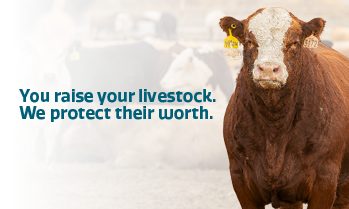FAQs
Get straight-forward, informed answers to your most important insurance questions.
AgriStability
-
Glad you asked...
There are many risks to the success of your farm operation, but not all risks are the same. Some risks may impact one aspect of your business, while other risks may affect multiple areas of your business. AgriStability operates under a model which combines risks and how they impact the profitability of your entire farm.
Example: an increase in fertilizer costs may reduce a farm's profit, but alone it might not significantly impact the farm's margin to generate an AgriStability benefit. However, if the increase in fertilizer prices is combined with a drop in commodity prices, the overall impact could be significant. The combined effect of higher costs and lower revenue from crop sales might be enough to generate a benefit from the Program.
-
Glad you asked...
AgriStability is a margin-based program looking at your farm's income and expenses. To accurately assess the financial success of your farm, we consider changes in inventory value from the start of the fiscal year to the end of the fiscal year. This involves keeping track of your opening inventory (what commodities you had on-hand at the start of the year) and your closing inventory (what commodities you had on-hand at the end of the year). The difference in value between the two, whether it’s related to price or production, can significantly impact the eligibility for AgriStability benefits.
Capturing accrual adjustments contributes to the full picture of your farm’s fiscal year financial success. Evaluating this against your farm’s historical performance is essential to assess potential program benefits. Click here to learn more about how we calculate margins: Margins | SCIC.
-
Glad you asked...
We understand no two farms are the same. While there may be similarities in land bases or crops grown, you make personalized decisions best suited for your farm. Some of these decisions include:
- Nutrient management
Timing of calving, farrowing, lambing and kidding
Feed programs
Crop types and varieties
The nature of the Program responds to risks of your particular operation, ensuring individualized support rather than a one-size-fits-all approach.
-
Glad you asked...
AgriStability responds when significant factors are outside your control, causing a substantial reduction in your farm’s profitability. In the program years (2018-2023), Saskatchewan producers received over $565 million in AgriStability benefit payments.
-
Glad you asked...
It is a misconception receiving a Crop Insurance payment means you won't receive an AgriStability benefit. Under the AgriStability Program, Crop Insurance indemnities are considered allowable income. Both programs work together to support your farm’s financial stability. Crop Insurance helps protect against risks during the crop’s seeding and growing season. After harvest, the coverage ends. AgriStability provides protection for other risks associated with that crop. This includes storage, input expenses and market price declines.
Depending on the size of the market drop, the price decline might not be enough to drive a payment from AgriStability. However, when combined with production loss, there are often benefits generated for producers (even if they got a Crop Insurance payment). This is because of the valuation of inventory - a component included in the AgriStability Calculation of Benefit.
-
Glad you asked...
Crop Insurance indemnities are allowable income for AgriStability. Crop Insurance covers crop production risk. Including Crop Insurance indemnities in the AgriStability Program helps ensure a producer's reference margin remains strong. Your reference margin is the level of coverage you have under the Program. When your margin falls below your reference margin for factors impacting the profitability of your farm, support can be provided from AgriStability. Some factors impacting your farm may include lower commodity prices, higher input costs or production loss.
-
Glad you asked...
AgriStability provides coverage for inventory value and can compensate for the declines which significantly impact the farm's profitability. Inventory devaluation can occur when stored grain drops in grade or when market prices decline. You may harvest and store grain at a high grade. However, negative events can impact the crop's marketability and the value of the inventory. This includes heating in the bin, bugs in the grain or wildlife damaging grain bags.
-
Glad you asked...
When the bottom line of a livestock operation is threatened, AgriStability responds just as it does for grain and oilseed operations. When combining allowable expenses with reduced revenue, it can significantly impact overall profitability. Historically, the AgriStability Program responds well, providing significant benefits to cattle producers.
First, we look at your farm or ranch's revenue. Did your revenue decrease due to factors such as price drops or fewer animals sold at market? Reduced income impacts the farm’s profitability.
Next, we assess your expenses. Did costs increase to produce marketable livestock? Were feed costs higher? Were there additional veterinary expenses? Did you need to transport animals for feeding? All these are allowable expenses.
-
Glad you asked...
For livestock operations, maintaining a healthy herd can be a significant risk. Saskatchewan cattle operators go to great lengths to raise the best animals possible. AgriStability regularly provides benefits, in circumstances when even the best planning goes array.
Example: a farm operation purchased prepared feed for their livestock. Unknown to the producer, the feed was not as advertised, resulting in about half the cow herd being open. This reduced the calf crop on the farm, driving revenues down. The AgriStability Program considers that decline in revenue and can compensate based on the drop in margin.
-
Glad you asked...
We often hear mixed farms don’t benefit from AgriStability because one side of the business offsets losses from others (e.g. higher cattle prices offset lower crop prices). Even well diversified farms (running multiple lines of business) can benefit from the AgriStability Program.
AgriStability is a whole-farm income program that considers the revenue and expenses across the operation. Even if your farm diversifies to mitigate risks, AgriStability can still help. When mixed farms receive a benefit from AgriStability, it typically indicates part of their business faced significant hardship, affecting the farms' overall margin.
Example: In 2023, drought led to a decline in grain production and prices. In this same year, cattle markets experienced record high prices. Some farms experienced significant losses, offsetting the gains from the cattle side of the business. When considering the overall profitability of the operation, if the farm suffers, AgriStability can provide a benefit.
-
Glad you asked...
The AgriStability Program covers all sizes and types of farm operations. Coverage and benefits are determined using your farm’s historical financial profile. The current year is compared against the historical profile to determine any benefits. The Program provides the same level of support - paying benefits when a farm’s profitability falls by 30 per cent, compared to its historical profitability. Smaller farms can access benefits just like larger farms, but the amount is typically smaller.
-
Glad you asked...
A farm receives an AgriStability benefit when the farm’s margin has fallen more than 30 per cent compared to the reference margin. In the following year, this margin can be included in the reference margin calculation. Depending on whether it becomes one of the three years used in the Olympic average, a year with a reduced margin can impact the calculated amount of margin covered under the Program.
The Olympic average used to determine the reference margin excludes the highest and lowest years, averaging the remaining three. Typically, one very bad year does not significantly affect your farm operation’s reference margin. However, when multiple low years occur, the reference margin can begin to decrease, leading to reduced coverage under the Program.
-
Glad you asked...
We understand there are other significant costs affecting the success and profitability of a farm operation. The AgriStability Program focuses solely on the operational side of the business, considering income and expenses from the production of primary commodities. Fixed costs and capital costs are not included in the AgriStability benefit calculation.
Each farm is unique in its makeup, approach and business decisions. Decisions about future production and marketing should not be influenced by business risk management programs such as AgriStability. Choices like buying or renting land, purchasing or leasing machinery, repairing or replacing equipment are discretionary and based on each farm's individual situation. To ensure fairness and avoid influencing management decisions, these types of costs are not included in the Program. The intent of AgriStability is to ensure fairness for all participating farms. Decisions regarding machinery are highly variable depending on the farm’s approach. Some farms choose to lease a significant portion of their equipment, while others decide to purchase and own equipment for longer periods, relying on maintenance and repairs. Both approaches are valid and based on the farm’s needs and the operator’s decision. However, they can have dramatically different impacts on business costs. Including these expenses in the AgriStability program would not treat all farms fairly.
-
Glad you asked...
Participating in AgriStability is low cost, with fees determined by the size of your operation's margin. The fee is $315 for every $100,000 being covered. On average this works out to a cost of $0.72 per acre and $1.14 per head.
Getting a Program benefit does not change your participation cost. Only your margin is used to calculate your premium. If your margin goes up, the cost to participate goes up. If it goes down, the cost to participate goes down.
Example: A farm with 3,000 acres of grain, forage and pastureland with 50 cow-calf pairs, would pay approximately $2,274 annually to participate. There is also a $55 administrative fee added to the amount each year. Why is $2,274 considered low cost? A farm with 3,000 acres of grain, forage and pastureland, with 50 cow-calf pairs, would have a margin of approximately $700,000. If the producer received a benefit of $200,000 one year, one benefit would cover the fee which is paid by the farm each year for around 90 years.
-
Glad you asked...
We are here to help. SCIC has program advisors located across the province, to support producers in clarifying needed information to complete forms. While they won’t fill in the forms for you, they can work with you to ensure you submit the correct information. Additionally, we offer a toll-free line for assistance. Our team is available to answer any questions and provide advice on how to complete your Program forms.
The reported income and expense come directly from your annually submitted tax information. Additional information needed consists of inventory information, accounts receivable (deferrals), accounts payable and if you have pre-purchased inputs for next year’s crop.
-
Glad you asked...
Agriculture is constantly changing - mergers, acquisitions, farm sales and new business structures. AgriStability measures a farm’s historical performance, but it is crucial to ensure this measurement reflects the current state of the farm. The size or structure of your farm five years ago may look quite different from today. If a farm increases in size, the reference margin needs to be increased to represent the potential historical performance to what it is now. Similarly, if a farm decreases in size, the history needs to be adjusted to reflect the performance potential of the same size of farm in those previous years. Therefore, structure change is incorporated into the calculation, making it an important part of the Program.
-
Glad you asked...
Lending institutions look to AgriStability, to secure loans and lines of credit. Lenders are more confident in providing financing to operations enrolled in the AgriStability Program. The AgriStability margin provides ag lenders with an understanding of the operation's financial situation.
Example: Whether applying for a livestock advance or a pre-harvest advance for crops, AgriStability can be leveraged as security for the cash advance.
-
Glad you asked...
The AgriStability enrolment deadline for the existing Program is extended for the 2025 program year to July 31, 2025. Producers enrolled in the Program must pay their program fees by December 31 to be eligible to receive program benefits. There is a penalty for fees paid after the deadline (or 30 days after their enrolment fee/notice), whichever is later.
To participate in AgriStability, please contact us and request a new participant package.
-
Glad you asked...
This can vary from company to company, but in most cases, it is the difference between the amount the producer committed to deliver and the actual amount they must meet for the commitments of the forward contract.
To learn more, click here.
-
Glad you asked...
In the event you cannot meet the obligations of the contract, you may decide to purchase inventory to fulfill the contract. The income and expense related to purchasing inventory to meet the shortfall of the contract is allowable, if the operation has the resources/capacity to produce the commodity at the amounts which are contracted.
To learn more, click here.
-
Glad you asked...
Yes, however, it is the shortfall between the actual production amount the producer has the ability to deliver on and the volume committed to in the forward contract which AgriStability considers allowable. In situations where producers did not produce enough grain to fulfill their contracts, they can enter the expense incurred to buy out the shortfall of their contracts under code 9836 Commissions and Levies. The shortfall represents only the quantity of the contract they were unable to fill, and not the cost to buy out the entire contract to obtain a better price.
-
Glad you asked...
An interim benefit payment is an advance on your final AgriStability benefit payment. You can apply for an interim benefit if you need access to program funds before completing your program year.
Saskatchewan producers can apply for an interim benefit, by March 31, to receive 50 per cent of their estimated final benefit before completing their program year. The interim benefit is calculated based on the estimated margin decline or loss for the year when compared to the reference margin (historical average).
Please call the AgriStability Call Centre to see if you may be eligible to receive an interim benefit.
-
Glad you asked...
Absolutely! SCIC encourages producers to consider participating in both Crop Insurance and AgriStability Programs as part of a comprehensive risk management plan for their farming operation.
With Crop Insurance, you have coverage for your crops from the start of seeding season until harvest is complete. Through AgriStability, you have even further coverage for other uncontrollable events throughout the year, such as, rising input costs, falling commodity prices or unforeseen additional expenses. Since AgriStability accounts for the whole farm, the Program can provide benefit payments even if you also receive a Crop Insurance payment.
-
Glad you asked...
The deadline to submit AgriStability forms without penalty is June 30.
Submitting program forms is part of the annual process for producers enrolled in AgriStability. The information provided determines whether each producer qualifies for a payment. It also ensures the farm’s reference margin, which payments are based upon, is up to date.
Program forms received after June 30, may be subject to a penalty fee. AgriStability benefits will be reduced by $500 per month; however, if no benefit is calculated, there is no penalty applied. Program forms, with penalty, must be submitted by September 30.








